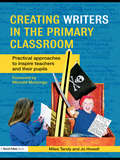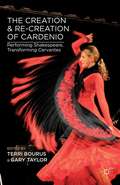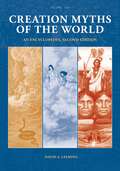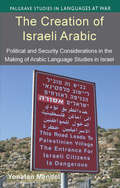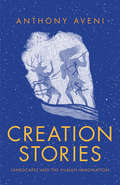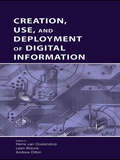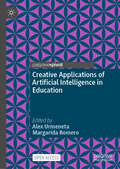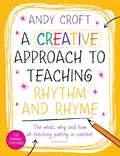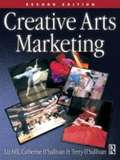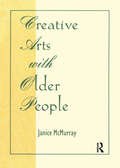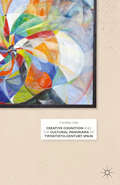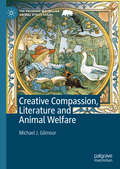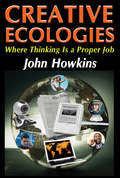- Table View
- List View
Creating Worldviews: Metaphor, Ideology and Language
by James W. UnderhillEncouraging readers to reflect upon language and the role metaphor plays in patterning ideas and thought, this book first offers a critical introduction to metaphor theory as it has emerged over the past thirty years in the States. James W. Underhill then widens the scope of metaphor theory by investigating not only the worldview our language offers us, but also the worldviews which we adapt in our own ideological and personal interpretations of the world. This book explores new avenues in metaphor theory in the work of contemporary French, German and Czech scholars. Detailed case studies marry metaphor theory with discourse analysis in order to investigate the ways the Czech language was reshaped by communist discourse, and the way fascism emerged in the German language. The third case study turns metaphor theory on its head: instead of looking for metaphors in language, it describes the way language systems (French & English) are understood in terms of metaphorically-framed concepts evolving over time. Including a multilingual glossary of key terms and concepts, this is an ideal volume for anyone new to the topic, as well as those already interested in metaphor theory and the analysis of worldviews.
Creating Writers in the Primary Classroom: Practical Approaches to Inspire Teachers and their Pupils
by Miles Tandy Jo HowellTeachers in English schools have now had ten years of prescriptive national literacy strategies and it is time for a new approach. This book encourages children from their early years to think of themselves as writers who have something to write and know how to write it. Creating Writers in the Primary Classroom offers an exciting and refreshing approach to teaching writing in the primary school with very practical suggestions to help build a community of writers in your school where everyone writes and loves writing. Building on the research of recent years and with whole-curriculum provision, it shows teachers how to actively engage children in the writing process, excite them about what they can achieve and help all children to think of themselves as writers. The book begins with a clear analysis of what real writers really need and has chapters on working outdoors, using the very best of children’s literature, drama and imaginative play, as well as sounds and images. It also features a chapter on practical, productive planning, including two case studies that show the approaches in use at schools. Creating Writers in the Primary Classroom is packed with practical advice, games and strategies for the classroom based on the authors’ successful experience as teachers and in-service providers. These new approaches will enable teachers to get their children up and moving, experiencing what writers experience, feeling what writers feel and, most important of all, writing how writers write.
Creating Writers in the Primary Classroom: Practical Approaches to Inspire Teachers and their Pupils
by Miles Tandy Jo HowellTeachers in English schools have now had ten years of prescriptive national literacy strategies and it is time for a new approach. This book encourages children from their early years to think of themselves as writers who have something to write and know how to write it. Creating Writers in the Primary Classroom offers an exciting and refreshing approach to teaching writing in the primary school with very practical suggestions to help build a community of writers in your school where everyone writes and loves writing. Building on the research of recent years and with whole-curriculum provision, it shows teachers how to actively engage children in the writing process, excite them about what they can achieve and help all children to think of themselves as writers. The book begins with a clear analysis of what real writers really need and has chapters on working outdoors, using the very best of children’s literature, drama and imaginative play, as well as sounds and images. It also features a chapter on practical, productive planning, including two case studies that show the approaches in use at schools. Creating Writers in the Primary Classroom is packed with practical advice, games and strategies for the classroom based on the authors’ successful experience as teachers and in-service providers. These new approaches will enable teachers to get their children up and moving, experiencing what writers experience, feeling what writers feel and, most important of all, writing how writers write.
The Creation and Re-Creation of Cardenio: Performing Shakespeare, Transforming Cervantes
by Terri Bourus and Gary TaylorDid Shakespeare really join John Fletcher to write Cardenio, a lost play based on Don Quixote? With an emphasis on the importance of theatrical experiment, a script and photos from Gary Taylor's recent production, and essays by respected early modern scholars, this book will make a definitive statement about the collaborative nature of Cardenio.
Creation Myths of the World [2 volumes]: An Encyclopedia [2 volumes]
by David A. LeemingThe most comprehensive resource available on creation myths from around the world—their narratives, themes, motifs, similarities, and differences—and what they reveal about their cultures of origin.ABC-CLIO's breakthrough reference work on creation beliefs from around the world returns in a richly updated and expanded new edition. From the Garden of Eden, to the female creators of Acoma Indians, to the rival creators of the Basonge tribe in the Congo, Creation Myths of the World: An Encyclopedia, Second Edition examines how different cultures explain the origins of their existence.Expanded into two volumes, the new edition of Creation Myths of the World begins with introductory essays on the five basic types of creation stories, analyzing their nature and significance. Following are over 200 creation myths, each introduced with a brief discussion of its culture of origin. At the core of the new edition is its enhanced focus on creation mythology as a global human phenomenon, with greatly expanded coverage of recurring motifs, comparative themes, the influence of geography, the social impact of myths, and more.
The Creation of Israeli Arabic: Security and Politics in Arabic Studies in Israel (Palgrave Studies in Languages at War)
by Y. MendelThis book sheds light on the ways in which the on-going Israeli-Arab conflict has shaped Arabic language instruction. Due to its interdisciplinary nature it will be of great interest to academics and researchers in security and middle eastern studies as well as those focused on language and linguistics.
Creation Stories: Landscapes and the Human Imagination
by Anthony AveniAn accessible exploration of how diverse cultures have explained humanity’s origins through narratives about the natural environment Drawing from a vast array of creation myths—Babylonian, Greek, Aztec, Maya, Inca, Chinese, Hindu, Navajo, Polynesian, African, Norse, Inuit, and more—this short, illustrated book uncovers both the similarities and differences in our attempts to explain the universe. Anthony Aveni, an award-winning author and professor of astronomy and anthropology, examines the ways various cultures around the world have attempted to explain our origins, and what roles the natural environment plays in shaping these narratives. The book also celebrates the audacity of the human imagination. Whether the first humans emerged from a cave, as in the Inca myths, or from bamboo stems, as the Bantu people of Africa believed, or whether the universe is simply the result of Vishnu’s cyclical inhales and exhales, each of these fascinating stories reflects a deeper understanding of the culture it arose from as well as its place in the larger human narrative.
Creation, Use, and Deployment of Digital Information
by Herre Van Oostendorp Leen Breure Andrew DillonThe aim of this book is to present results of scientific research on how digital information should be designed and how artifacts or systems containing digital content should maximize usability, and to explain how context can influence the nature and effectiveness of digital communication. Using a philosophical, cognitive, and technical standpoint, the book covers the issue of what digital information actually is. The text also presents research outcomes from the perspective of research in information science--broadly construed--a term now used to cover a range of theoretical and practical approaches.Creation, Use, and Deployment of Digital Information is broken down into three parts:*Part I presents information on how electronic documents can be realized--the complexities, alternatives, functions, and restrictions are treated here.*Part II discusses how human beings process information and how technical solutions can satisfy human restrictions.*Part III treats the context in which digital information processing and deployment takes place.The book has much to offer to academics in many disciplines, including science, the arts, psychology, education, and the information and computing sciences.
Creation, Use, and Deployment of Digital Information
by Herre Van Oostendorp Leen Breure Andrew DillonThe aim of this book is to present results of scientific research on how digital information should be designed and how artifacts or systems containing digital content should maximize usability, and to explain how context can influence the nature and effectiveness of digital communication. Using a philosophical, cognitive, and technical standpoint, the book covers the issue of what digital information actually is. The text also presents research outcomes from the perspective of research in information science--broadly construed--a term now used to cover a range of theoretical and practical approaches.Creation, Use, and Deployment of Digital Information is broken down into three parts:*Part I presents information on how electronic documents can be realized--the complexities, alternatives, functions, and restrictions are treated here.*Part II discusses how human beings process information and how technical solutions can satisfy human restrictions.*Part III treats the context in which digital information processing and deployment takes place.The book has much to offer to academics in many disciplines, including science, the arts, psychology, education, and the information and computing sciences.
Creative Applications of Artificial Intelligence in Education (Palgrave Studies in Creativity and Culture)
by Alex Urmeneta Margarida RomeroThis open access book explores the synergy between AI and education, highlighting its potential impact on pedagogical practices. It navigates the evolving landscape of AI-powered educational technologies and suggests practical ways to personalise instruction, nurture human-AI co-creativity, and transform the learning experience. Spanning from primary to higher education, this short and engaging volume proposes concrete examples of how educational stakeholders can be empowered in their AI literacy to foster creativity, inspire critical thinking, and promote problem-solving by embracing AI as a tool for expansive learning. Structured in three parts, the book starts developing the creative engagement perspective for learning and teaching to then present practical applications of AI in K-12 and higher education, covering different fields (teacher education, professional education, business education) as well as different types of AI supported tools (games, chatbots, and AI assisted assessment). It also delves into the ethical considerations, policy implications, and the central role educators play in harnessing the power of an AI informed educational experience.
A Creative Approach to Teaching Grammar
by Peter BurrowsThis book offers a whole school approach to the teaching of grammar and punctuation that is fully matched to the demands of the English grammar and punctuation test and the new curriculum. With the shift towards elegant, well-constructed sentences, it offers the busy teacher three simple steps to motivate and engage children, through:• explicit teaching and modelling; • over forty practical games and activities;• application and improvement within editing and proof reading.This book draws on recent research but also is based on many years of classroom practice and a number of case studies. Practical examples develop teachers' understanding of grammatical terms and progression and show how it is possible to have a significant impact on vocabulary, sentence structure and children's writing in general. A balance is found where skills are explicitly taught but within the context of an exciting and interesting curriculum.
A Creative Approach to Teaching Grammar
by Peter BurrowsThis book offers a whole school approach to the teaching of grammar and punctuation that is fully matched to the demands of the English grammar and punctuation test and the new curriculum. With the shift towards elegant, well-constructed sentences, it offers the busy teacher three simple steps to motivate and engage children, through:• explicit teaching and modelling; • over forty practical games and activities;• application and improvement within editing and proof reading.This book draws on recent research but also is based on many years of classroom practice and a number of case studies. Practical examples develop teachers' understanding of grammatical terms and progression and show how it is possible to have a significant impact on vocabulary, sentence structure and children's writing in general. A balance is found where skills are explicitly taught but within the context of an exciting and interesting curriculum.
A Creative Approach to Teaching Rhythm and Rhyme
by Andy CroftThe content of this book is based on the Andy Croft's experience of working with children in over 400 UK schools and will provide teachers with ideas, games, examples and models that they can use in the classroom to encourage their children to become writers and readers through the practice of rhyme and rhythm. He strongly believes that you don't have to be 'good at English' to be able to enjoy the music of ordinary speech. Using rhythm and rhyme is a democratic creative act that is equally hard and equally easy for everyone. It has special rules which won't let you reach for the first word that comes into your head. Your words have to fit the pattern. You don't have to write anything down, but you do have to become a writer. And once you have become a writer, you might become a reader...
Creative Approach to Teaching Spelling: The What, Why And How Of Teaching Spelling, Starting With Phonics!
by Kate RobinsonA Creative Approach to Teaching Spelling is packed full of fun and effective multi-sensory games and activities that build phonic skills as a key strategy for spelling. In addition, there are games that develop further strategies to supplement phonic skills. Preceding the games is a summary of major developments in the teaching of spelling over the last forty years. This leads to an analysis of the current research and approaches on which the games are based. With the knowledge, skills and ideas offered, teachers can enhance the growing range of phonic-based spelling programmes currently used within schools, or they can build engaging spelling programmes of their own to meet the specific groups or individual pupils.The games and activities will help to develop and embed children's phonological awareness, phonic knowledge and auditory memory.
Creative Approach to Teaching Spelling: The What, Why And How Of Teaching Spelling, Starting With Phonics
by Kate RobinsonA Creative Approach to Teaching Spelling is packed full of fun and effective multi-sensory games and activities that build phonic skills as a key strategy for spelling. In addition, there are games that develop further strategies to supplement phonic skills. Preceding the games is a summary of major developments in the teaching of spelling over the last forty years. This leads to an analysis of the current research and approaches on which the games are based. With the knowledge, skills and ideas offered, teachers can enhance the growing range of phonic-based spelling programmes currently used within schools, or they can build engaging spelling programmes of their own to meet the specific groups or individual pupils.The games and activities will help to develop and embed children's phonological awareness, phonic knowledge and auditory memory.
A Creative Approach to Teaching Writing (Get them Thinking like …)
by Steve BowkettWhy should children learn to write fluently? What difference will it make to them and the opportunities available to them later on in life? The ability to communicate clearly, accurately and persuasively is a vital life skill. Deficiencies in motivation and thinking skills pervade the challenge of improving children's literacy levels. Get Them Thinking Like Writers! combines practical activities to help children aged 7-11 develop their writing skills, with insights into the attitude that experienced writers apply to their craft. The activities explore different working methods - such as how authors tap into and develop their creativity and how they deal with 'writer's block' - and are supported by strategies for thinking that will develop children's literacy and the way they use language to express their opinions in all subject areas. Steve Bowkett, author, storyteller and education consultant, provides the key concepts and learning benefits of each strategy, along with a series of activities, extension ideas and useful links. Linked resources can be found on the series companion website.
A Creative Approach to Teaching Writing (Get them Thinking like …)
by Steve BowkettWhy should children learn to write fluently? What difference will it make to them and the opportunities available to them later on in life? The ability to communicate clearly, accurately and persuasively is a vital life skill. Deficiencies in motivation and thinking skills pervade the challenge of improving children's literacy levels. Get Them Thinking Like Writers! combines practical activities to help children aged 7-11 develop their writing skills, with insights into the attitude that experienced writers apply to their craft. The activities explore different working methods - such as how authors tap into and develop their creativity and how they deal with 'writer's block' - and are supported by strategies for thinking that will develop children's literacy and the way they use language to express their opinions in all subject areas. Steve Bowkett, author, storyteller and education consultant, provides the key concepts and learning benefits of each strategy, along with a series of activities, extension ideas and useful links. Linked resources can be found on the series companion website.
Creative Arts Marketing (2nd edition) (PDF)
by Elizabeth Hill Terry O'Sullivan Catherine O'SullivanAs a comprehensive overview of all aspects of marketing in the sector, Creative Arts Marketing remains unrivalled, and in addition this edition gives new coverage of- * Current knowledge and best practice about marketing and advertising through new media * The impact of Relationship Marketing techniques * A wholly revised and enhanced set of cases * Entirely revised and updated data on the arts 'industry' Creative Arts Marketing reflects the diversity of the arts world in its wide ranging analysis of how different marketing techniques have worked for a diverse range of arts organizations. As such it is an invaluable text for both students and arts managers As a comprehensive overview of all aspects of marketing in the sector, Creative Arts Marketing remains unrivalled, and in addition this edition gives new coverage of- * Current knowledge and best practice about marketing and advertising through new media * The impact of Relationship Marketing techniques * A wholly revised and enhanced set of cases * Entirely revised and updated data on the arts 'industry' Creative Arts Marketing reflects the diversity of the arts world in its wide ranging analysis of how different marketing techniques have worked for a diverse range of arts organizations. As such it is an invaluable text for both students and arts managers
Creative Arts With Older People
by Janice McmurrayWith this insightful and intelligent book, professionals can help institutionalized older adults express themselves creatively. One of only a few books on expressive arts for older people, this unique, new volume is ideal for professionals who provide art activities for residents in adult homes and retirement communities.Creative experience can facilitate the expression of ideas and feelings, increase sensory stimulation, improve self-esteem, and improve social relationships. Creative Arts With Older People provides time-tested suggestions to stimulate the creative process among older adults, resulting in numerous physical, psychological, and social benefits. The author, an artist and a social worker, describes dozens of activities that have proven effective in her many years of working with older people--painting, movement, poetry, sculpting, puppetry, dramatic expression, and more. She explains the goals and advantages of each activity, includes a list of materials needed, and details the step-by-step process for conducting each activity.Creative Arts With Older People is a practical and valuable book for activity directors in adult homes and adult health care units, and workers in adult day care centers, adult psychiatric facilities, and senior centers.
Creative Arts With Older People
by Janice McmurrayWith this insightful and intelligent book, professionals can help institutionalized older adults express themselves creatively. One of only a few books on expressive arts for older people, this unique, new volume is ideal for professionals who provide art activities for residents in adult homes and retirement communities.Creative experience can facilitate the expression of ideas and feelings, increase sensory stimulation, improve self-esteem, and improve social relationships. Creative Arts With Older People provides time-tested suggestions to stimulate the creative process among older adults, resulting in numerous physical, psychological, and social benefits. The author, an artist and a social worker, describes dozens of activities that have proven effective in her many years of working with older people--painting, movement, poetry, sculpting, puppetry, dramatic expression, and more. She explains the goals and advantages of each activity, includes a list of materials needed, and details the step-by-step process for conducting each activity.Creative Arts With Older People is a practical and valuable book for activity directors in adult homes and adult health care units, and workers in adult day care centers, adult psychiatric facilities, and senior centers.
Creative Cognition and the Cultural Panorama of Twentieth-Century Spain
by C. GalaThis multidisciplinary study focuses on the creative state as the nucleus of the work of numerous poets, artists, and philosophers from twentieth-century Spain. Beginning with cognitive science, Gala explores the mental processes and structures that underline creative thinking, for poets like José María Hinojosa, Clara Janés, and Jorge Guillén.
Creative Compassion, Literature and Animal Welfare (The Palgrave Macmillan Animal Ethics Series)
by Michael J. GilmourThis book examines animal welfare themes in fiction, and considers how authors of the last two centuries undermine dominative attitudes toward the nonhuman. Appearing alongside the emerging humane movements of the nineteenth century and beyond is a kind of storytelling sympathetic to protectionist efforts well-described as a literature of protest. Compassion-inclined tales like the Dolittle adventures by Hugh Lofting educate readers on a wide range of ethical questions, empathize with the vulnerable, and envision peaceful coexistence with other species. Memorable characters like Black Beauty and Beautiful Joe, Ivan the gorilla and Louis the trumpeter swan, Hazel and Cheeta, Mr. Bultitude and Doctor Rat do not merely amuse. They are voices from the margins who speak with moral urgency to those with ears to hear. This broad survey of ethical themes in animal fiction highlights the unique contributions creative writers make toward animal welfare efforts.
Creative Criticism: an anthology and guide (PDF)
by Stephen Benson Clare ConnorsA guide to the creative possibilities of critical writing, with sample texts from writer/critics, including Anne Carson, Jacques Derrida, Geoff Dyer, Hélène Cixous, Ali Smith and John Cage. Designed for students, teachers and critics of literature and creative writing, and especially students who are required to write critical essays.
Creative Ecologies: Where Thinking Is a Proper Job (Creative Economy And Innovation Culture Se Ser.)
by Bronislaw Malinowski John HowkinsThe main question of our age is how we live our lives. As we struggle with this question, we face others. How do we handle ideas and knowledge, both our own and those of others? What relationship to ideas do we want? Whose ideas do we want to be surrounded by? Where do we want to think? Most choose, or have the choice made for them, according to what family, colleagues, and friends do and say and what we read about, and a more or less rational calculation of the odds.Modern ecology results from the shift in thinking generated by quantum physics and systems theory, from the old view based on reductionism, mechanics, and fixed quantities to a new view based on holistic systems where qualities are contingent on the observer and on each other. This perception changes how people treat ideas and facts, certainties and uncertainties, and affects both art and science. Worldwide it is part of the process of understanding the current crisis in the environment, and the balance of economy, creativity, and control required in our response.The book's starting point is the growing role that information has played in industrial economies since the 1800s and especially in the last thirty years. It is an attempt to identify ecology of thinking and learning. It is also based on the need to escape from old, industrial ways and become more attuned to how people actually borrow, develop, and share ideas. Throughout the book, Howkins asks questions and offers signposts. He gives no guarantee that creative ecologies will be sustainable, but shows what should be aimed for.
Creative Ecologies: Where Thinking Is a Proper Job
by Bronislaw Malinowski John HowkinsThe main question of our age is how we live our lives. As we struggle with this question, we face others. How do we handle ideas and knowledge, both our own and those of others? What relationship to ideas do we want? Whose ideas do we want to be surrounded by? Where do we want to think? Most choose, or have the choice made for them, according to what family, colleagues, and friends do and say and what we read about, and a more or less rational calculation of the odds.Modern ecology results from the shift in thinking generated by quantum physics and systems theory, from the old view based on reductionism, mechanics, and fixed quantities to a new view based on holistic systems where qualities are contingent on the observer and on each other. This perception changes how people treat ideas and facts, certainties and uncertainties, and affects both art and science. Worldwide it is part of the process of understanding the current crisis in the environment, and the balance of economy, creativity, and control required in our response.The book's starting point is the growing role that information has played in industrial economies since the 1800s and especially in the last thirty years. It is an attempt to identify ecology of thinking and learning. It is also based on the need to escape from old, industrial ways and become more attuned to how people actually borrow, develop, and share ideas. Throughout the book, Howkins asks questions and offers signposts. He gives no guarantee that creative ecologies will be sustainable, but shows what should be aimed for.

